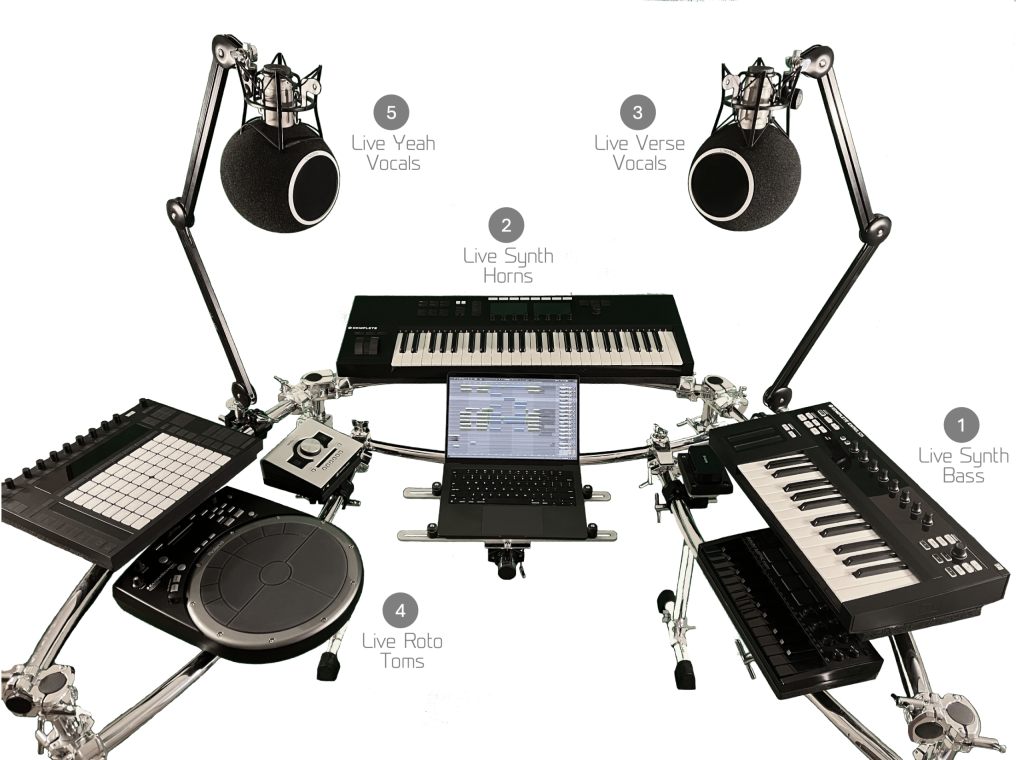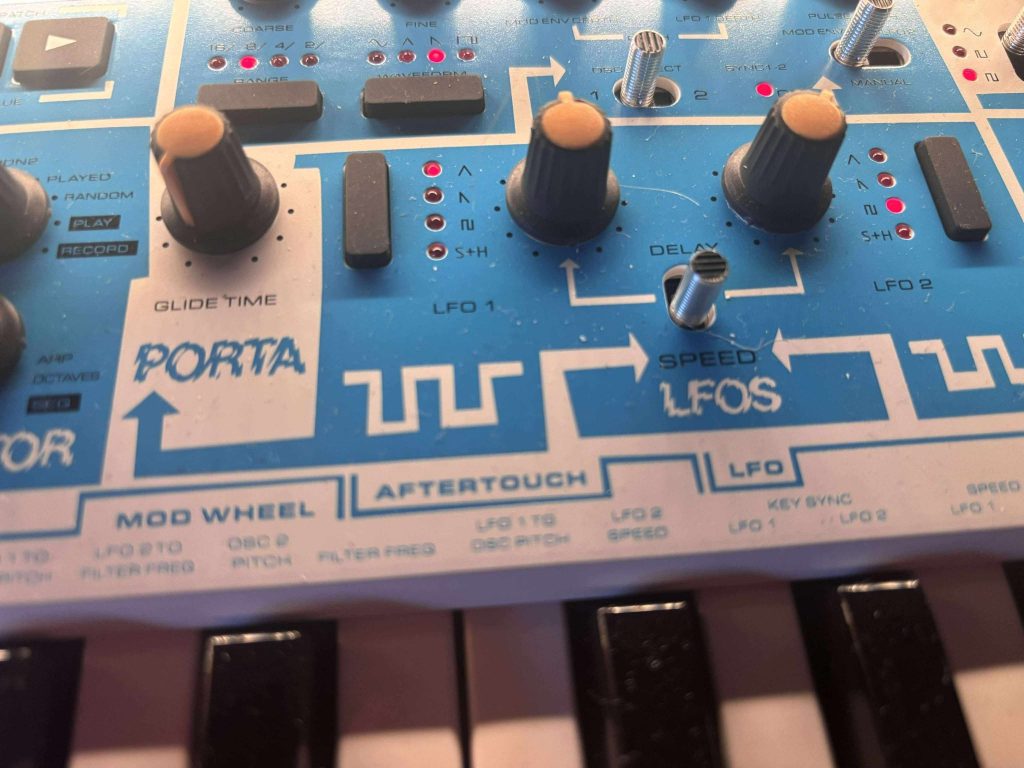Table of Contents
I’ve been aware of the Bass Station II for years, but somehow I’d never actually sat down with one until now. I knew the broad strokes — an affordable analogue monosynth with a reputation for being a modern classic — but I had no idea how it would feel in practice. The Bass Station II Swifty Edition seemed like the perfect entry point: same core synth as the standard model, but with a bold new panel design and a bank of fresh artist patches already loaded.
Coming in without muscle memory for its layout meant I got the genuine “first contact” experience; something I imagine so many people got well over a decade ago when the original one dropped, of which countless producers continue to swear by even to this day.
In fact, when Novation hit me up to see if I wanted to review it, it felt like doubly perfect timing, since I had recently watched a stream with Chris Lake where he was sweating the Bass Station as well (embedded below), so the stars alligned for me to jump at the chance to see what this can do by figuring out where everything lived, testing how quickly I could shape sounds, and seeing if it really lived up to the hype it’s built since 2013.
Right away, I understood why this synth has stuck around. It’s approachable but still has enough depth to keep you experimenting.
Design Collaboration With Ian “Swifty” Swift
The first thing that hit me was how different it looks from most synths I’ve used.
Swifty’s design chops show in the way the panel is divided, with each section feels like its own little workspace, and the arrows give you a natural path to follow, which is something I liked about the Korg MS20 Mini but also thought the Korg missed the mark a bit just by how steep its learnign curve was; that’s not the case with this synth. For someone learning the Bass Station II layout for the first time, this made a big difference. I didn’t need to stop and think “where’s that control again constantly?”
Visually, it’s loud compared to the usual black-and-grey synth panels. That won’t be for everyone, but I found it inspiring and added a nice splash of spice to my otherwise grim, dark desk of synths. It feels like a piece of creative gear, not just another instrument in a uniform chassis. The colours pop in low light, which I imagine would help a lot in a live setting.

The build is light and portable. The plastic casing doesn’t feel luxurious, and the keys don’t feel as tactile and sturdy as, say, my Minilogue, but it’s stable enough, and the knobs and faders move with a reassuring smoothness. It’s a synth I’d happily throw in a backpack for a session without worrying about it.

Bass Station II Swifty Edition‘s New Artist Patches
With zero previous Bass Station II programming experience, these artist patches were a great way to get a sense of what the synth can do. Legowelt’s sounds grabbed me immediately with their rich, saturated tones with a clear sense of character. Pecq’s patches are stranger and more mod-heavy, which gave me ideas I wouldn’t have come up with starting from scratch. Maria Chiara Argirò’s are smoother and more harmonic, showing a softer side of the synth that I didn’t expect from its name.

These presets are far from polished “final mix” sounds, but I actually liked that. They feel like conversation starters and are good jumping-off points that push you to twist a knob and make them your own, rather than overly accessible patches that don’t facilitate to getting in the weeds, and thus lose the flow of sound design (maybe that’s just me, though). Since I didn’t have my own go-to Bass Station patches yet, they were a shortcut into exploring its range.
Core Synthesis Architecture
Coming in fresh, I appreciated how easy it was to understand.
Two oscillators, a sub-oscillator, multiple waveforms, and straightforward tuning and sync options. The sound is full right out of the gate, even without heavy tweaking; you can get tones that feel substantial.

The two filter types give it more flexibility than I expected. The Classic filter is clean and adaptable, while the Acid filter has that unmistakable squelch when pushed. With the drive and distortion in play, it’s capable of some seriously aggressive tones, but you can also dial it back for more subtle work.
The modulation options are enough to get creative without feeling overwhelming. Two LFOs and two envelopes cover most of what I need. AFX Mode was new to me, and it’s a smart addition. The idea of having a different sound on every key is something I’d mostly associated with samplers, but here it opens up some unusual performance possibilities.
Performance Features and Workflow

As a first-time player, the workflow clicked quickly pretty quicly even if there is a lot going on with this synth. I know this is kind of comparing apples to oranges here, but this workflow is something I really wish my Korg MS20 had, but it’s only something I want to do after seeing how much the BSII knocks the visual flow out of the park.
The 25 keys are fine for basslines and leads, but you’ll want an external keyboard if you’re doing more than two-handed playing. The keybed is responsive, and aftertouch adds expression, which I used more than I expected.
The arpeggiator is straightforward to set up, and the sequencer is equally simple. You’re not going to program elaborate patterns in here, but for jamming ideas or building live loops, it’s more than enough. It has a very classic synth vibe that’s fun to noodle around with while watching a sci-fi movie on your second monitor (maybe I’m the only one who does that kind of thing, though?).
The biggest plus for me was the directness of control. I’ve used synths where finding the right parameter feels like a menu-mining exercise. Here, I always felt one or two moves away from getting the change I wanted. For a first encounter, that made the learning curve short and the results fast.
The setup was painless, also, not that it was any more or less complicated than your typical desktop-sized synth.

USB MIDI worked instantly with my DAW, and standard MIDI in/out means it slotted straight into my hardware chain. The option to power it via USB is handy if you’re travelling light, but for studio work I stuck with the included power supply. The sustain pedal input is basic but useful, especially for holding drones while tweaking.
No surprises here — the connectivity is what I’d expect, but everything worked without a hiccup.

Real-World Use Cases
After a couple of weeks with it, I’ve been using the Swifty Edition for three main things: basslines and retro acid-style leads. The bass it produces is as tight and punchy as I’d hoped, with enough control to sit right in a mix without requiring a lot of post-processing.
The acid leads are addictive, mostly because, no matter how hard they try, very few VSTs sound achieve that iconic sound and even most hardware pieces just are set up for it. The filter drive and distortion let you push it right into gritty territory, and I found myself losing track of time just tweaking filter resonance in real time (especially running it through a touch of delay on some of my pedals)
As someone who’s coming to the Bass Station II fresh, I can say it lives up to its reputation for value. The feature set, sound quality, and hands-on control put it in a sweet spot, more versatile than other monosynths in its price range, but still focused enough to avoid feeling bloated.
The Swifty Edition’s limited status will make it appealing to collectors, but that’s not the reason I’d recommend it. The real selling point is that it’s the current best version of a proven synth, with a panel layout that’s especially friendly to first-time users like me.
If you’re buying your first Bass Station II, you might as well get the one that gives you both the functional and aesthetic upgrade.
Conclusion
This was my first proper hands-on with a Bass Station, and the Swifty Edition made a great first impression. The design helped me learn it faster, the artist patches gave me a head start in exploring its range, and the core synth engine delivered exactly what I’d hoped for: solid, versatile analogue tone in a compact package.
It’s not perfect — the limited keys and basic aro will leave some wanting more — but those trade-offs are easy to accept given how quick it is to work with and how good it sounds. For me, it’s gone from “a synth I’ve always meant to try” to “a synth I’ll keep reaching for.”
If you’re new to the Bass Station II like I was, or hell, even to hardware synths in general, the Swifty Edition is the one to start with.
The post The Bass Station II Swifty Edition Made Me Wonder Why I Waited So Long to Try One [Review] appeared first on Magnetic Magazine.






